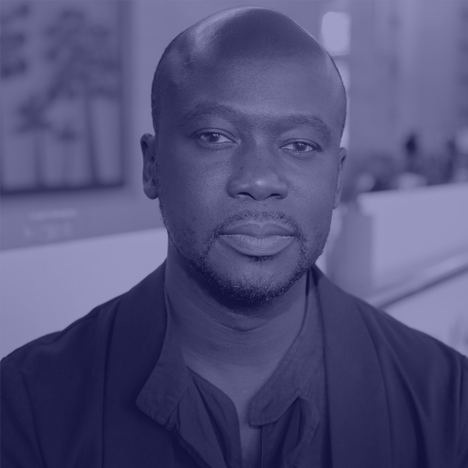
David Adjaye: "Africa offers an extraordinary opportunity"
Dezeen Book of Interviews: in the third extract from our latest book, London-based architect David Adjaye discusses his longstanding fascination with Africa and the opportunities it holds for architects.
During an interview at Design Indaba 2013 in South Africa, Adjaye spoke to Dezeen's editor-in-chief Marcus Fairs about his extensive survey Adjaye Africa Architecture and the new opportunities for architects working in Africa.
"Africa offers an extraordinary opportunity at the moment," explained Adjaye, who said that the continent's GDP growth was outperforming that of China.
"Suddenly with this rapid economic development, there is this mass migration into the cities, which is really traumatic. How do we plan for the expansion of these cities, which were originally built for a limited few?"
"With the right political agency and the right construction environment, you can create extraordinary moments in architecture. And that, for me, is very exciting."
Adjaye, who has several projects currently underway in Africa, has opened an office in Accra – the city Adjaye describes as "his ancestral home" – to focus on work on the continent.
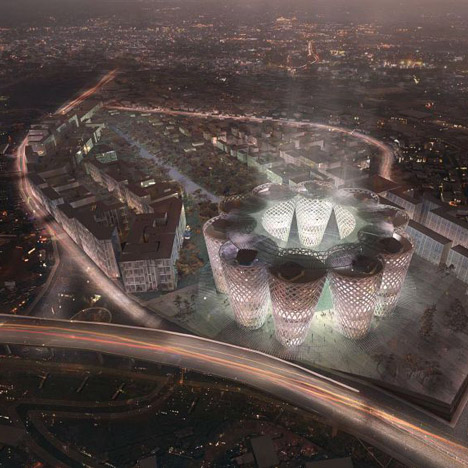
"Throughout Africa there is a great need for housing, so housing is incredibly important, and masterplanning, so we've developed those skills in the office and we have started to engage with that," he said.
"You'll see much more masterplanning and projects emerging from the Accra office that are very different from what usually comes from Adjaye Associates."
Born in Tanzania and educated in the UK, Adjaye had been working on an 11 year project to document the architecture of the continent and discover more about the geography and history behind modern Africa, as well as the political climates of its cities, towns and villages.
The project ended up forming the basis of a seven-volume book entitled Adjaye Africa Architecture, which was published in 2011.
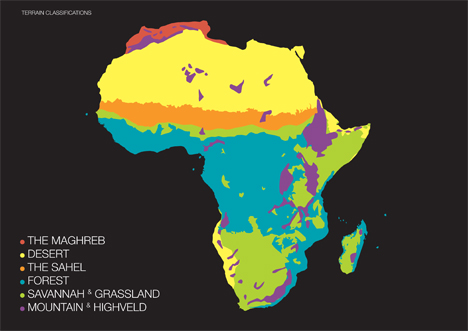
"We moved around so much that before I was 14 I had visited a dozen countries on the continent," he said. "From a very early age I had a complex view of the continent, from being in my father's village to seeing the metropolitan skyline of Nairobi, which, in the 1960s, was the incredible new modern city in Africa."
"After graduation I realised that I wanted to revisit the continent of Africa – not through the lens of my parents, or through any kind of formal experience like tourism – but I wanted to claim it for my own, as a set of experiences that were about my negotiation of people." he said.
"There are very extreme climates with extraordinary histories, which have created these incredible contemporary conditions. That is the lens through which you have to understand the continent."
Marcus Fairs: What is your relationship with Africa?
David Adjaye: I was born in East Africa of Ghanaian parents from West Africa. I grew up on the continent until I was 14, then I came to London, where I was educated. Africa was very important to me because that was a time when my father was a diplomat, at the peak of his career. We moved around so much that before I was 14 I had visited a dozen countries on the continent. From a very early age I had a complex view of the continent, from being in my father's village to seeing the metropolitan skyline of Nairobi, which, in the 1960s, was the incredible new modern city in Africa. I had also been to North Africa and experienced Muslim culture and Muslim architecture. So I was already negotiating the differences across the continent before I came to Europe.
Marcus Fairs: You've visited every country in Africa over the past few years. What drew you back?
David Adjaye: After graduation I realised that I wanted to revisit the continent of Africa – not through the lens of my parents, or through any kind of formal experience like tourism – but I wanted to claim it for my own, as a set of experiences that were about my negotiation of people. So I spent 11 years, from 1999 to 2010, visiting every single African country and documenting every capital to understand the nature of cities in Africa, to understand their past and their present, their history and their geography.
After I did that, I realised how profoundly the geography and the history had created the contemporary condition, which is the Africa we know now. There are very extreme climates with extraordinary histories, which have created these incredible contemporary conditions. That is the lens through which you have to understand the continent. It's very difficult to understand Africa if you don't take this on board.
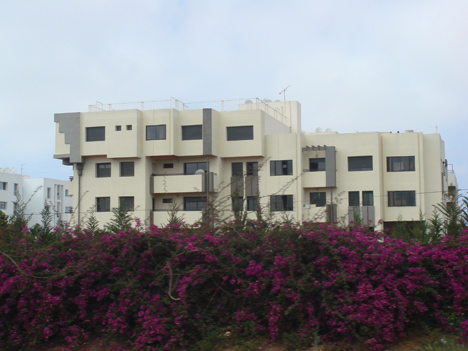
Marcus Fairs: So you're talking about understanding Africa as a series of climatic zones, rather than countries?
David Adjaye: Absolutely. In doing this 11-year study, what I suddenly realised is that, because of the colonial construction and the language construction, most Africans don't even know about their neighbours, because there might be a language barrier or a geographic barrier. What became clear to me from the political map of Africa is that we have a very difficult way of understanding the continent, and that fundamentally, the way to start looking at the continent is through geography.
I started doing a lot of research on the latest satellite and data maps and extracted a map that shows the continent now. What was clear was that unlike other continents, which have some hybrid zones, Africa has six absolutely distinct unique climates. There is no cross-pollination between them. The savanna is where the animal kingdom is. The super-dense forest is where the river deltas are, where the farm cultures are, where the great cultures are. Then there's the mountain highland, countries like Namibia and Ethiopia. You've got the desert, which goes from Niger to Egypt. And then you have the Maghreb, which covers the Mediterranean coast and the coastal plain, with interesting vegetation that buffers the Sahara from the forest. These are where all the civilisations of Africa have manifested themselves, and their unique identities come from this.
The artefacts of the continent reflect that geography, through the choice of the materials. There are a lot of animal crafts in the savanna lands; you see a lot of timber work in the forest lands and a lot of abstract elements in the desert lands. I think this comes from human beings responding to their extreme climates very precisely, and it has created a culture and a history that are very precise.

Marcus Fairs: Your research has now been published as a book.
David Adjaye: The book is called African Metropolitan Architecture, or Adjaye Africa Architecture. It has seven volumes divided into the different geographies, plus a book of essays. I'm really proud of this – there are ultimately 11 years of work included, the analysis of all the capital cities, the architectural highs and lows, the people's relation to their geography and their political and social histories.
Marcus Fairs: Do you have architectural projects in Africa?
David Adjaye: Yes I do. I have several projects in Africa. You know me, I'm very discreet about showing my work, but I’ve taken a lot of things on board. We're working in the cultural sector – culture and education are areas that, again, I am most connected to. But also we're doing commercial work here. Throughout Africa there is a great need for housing, so housing is incredibly important, and masterplanning, so we've developed those skills in the office and we have started to engage with that.
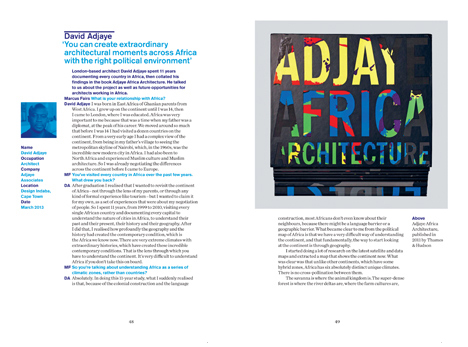
We’ve just opened an office in Accra, which is my ancestral home. You'll see much more masterplanning and projects emerging from the Accra office that are very different from what usually comes from Adjaye Associates. So it's very important for me that we have this office, and from there I hope to be able to work more specifically on the continent.
Marcus Fairs: What opportunities does Africa offer architects? How is it changing?
David Adjaye: Africa offers an extraordinary opportunity at the moment; an opportunity and a paradox at the same time. What you have, which has been noted by various institutes, is GDP growth on the continent anywhere from ten to 15 percent, which is extraordinary. It's greater than what China was doing. But it's trickling and it's changing the political paradigm, because as people are becoming more wealthy, they are starting to question their political structure. I think you are finding the political guards shifting now, and being shaken.

But also there's the idea of the city that's being really thought through. Africa is a continent of rapid urbanisation. We had been seeing a stagnation of people moving from the agrarian landscape to the city, simply because the poor economies meant there was no need to come to the city. Suddenly with this rapid economic development, there is this mass migration into the cities, which is really traumatic. How do we plan for the expansion of these cities, which were originally built for a limited few? Most of the cities were built as small, elite centres. How do they grow while taking on board the issues of their colonial past? How do they take on modern planning in light of their heritage and history?
These, I think, are cosmopolitan paradoxes that the wider world is facing on a different scale. And they present fantastic opportunities. With the right political agency and the right construction environment, you can create extraordinary moments in architecture. And that, for me, is very exciting.
The kind of architecture I'm interested in seeks to make sense of environments that may seem chaotic, or programmes and ideas that seem not to have any architectural relevance but actually do. And when they are birthed, they have a profound effect on how we think and see ourselves in the world. Architecture can do that, and I'm very moved by that.